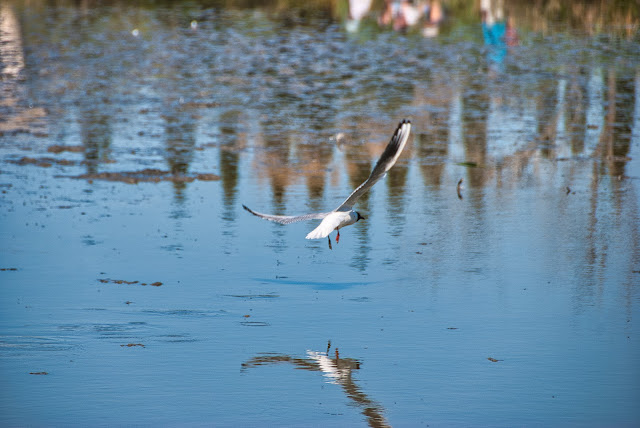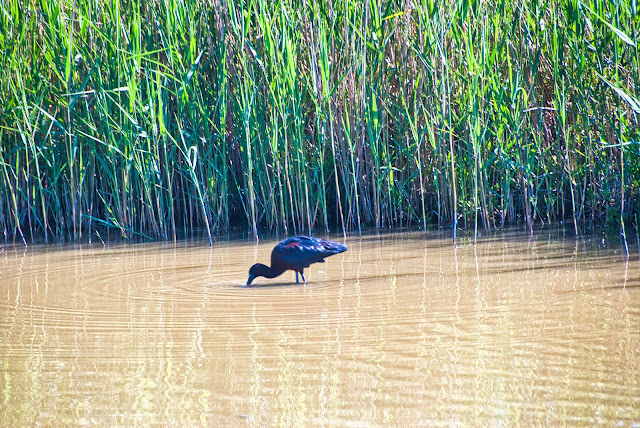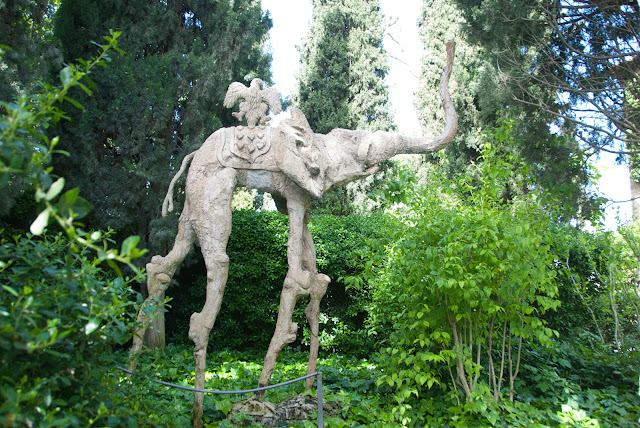Disgruntled, but not totally dispirited, we pushed on to Figueres, which would become one of our favorite destinations on the trip. Figueres is just over the border into Spain from France and was the home of Salvador Dali. We arrived in the town and checked into the Duran hotel. We didn’t realize that when we booked, but this hotel was a favorite stomping ground for Dali and it just oozed character. We set out to find a tapas bar to enjoy an early dinner. Our hotel was adjacent to La Rambla, the heart of Figueres. As we approached, we realized that the entire plaza area was filled with merchants, selling everything from wine to flip-flops. And it appeared that the entire population of the town was wandering La Rambla and surveying the offerings. We stationed ourselves on stools adjacent to the pedestrian way and indulged in tapas eating and people watching.
 |
| Vendors were set up selling their various wares... |
 |
| while some people were sitting at table, enjoying tapas, their favorite beverage and the company of friends. |
 |
| The vendors were selling everything from wine and olive oil, |
 |
| cheese and more wine... |
 |
| and even anchovies. |
 |
At one end of the Rambla is this colorful statue of Narcís Monturiol (Figueres 1819 - Barcelona 1885), who spent his life as an artist & intellectual. He was the editor of La Fraternidad, the first communist newspaper of Spain, and in his spare time invented the first air independent and combustion powered submarine.
|
The next day was dedicated to all things, Dali. First, we visited the Dali family home a mere few blocks from our hotel. His family was well off, his father was a lawyer, and their home reflects their influence. After a quick look at that, we proceeded to the Dali theater/museum. Dali purchased the ruined theater in the 1960s and spent over 20 years turning it into an amazing, eccentric and captivating location to display his captivating and eccentric works of art.
 |
| The house where Dali was born with a photo of Dali as a very young child on the left. |
 |
| Dali's surrealism has influenced other artists, such as the one who decorated these lockers. |
 |
There was also more traditional artwork like this mural with text from the novel La Sed.
|
Dali‘s private life was as interesting as his artistic life. His lifelong love was a Russian immigrant named Gala who was 10 years older and every bit as eccentric as Dali was. To say their relationship was unusual would be to perhaps understate the case. According to Dali’s biography, he was so traumatized in adolescence by photos, revealing the ravages of venereal disease that he forgoes “full on“ sex throughout his life. Should you have further interest in the subject? It’s only a Google away. In spite of their various hangups, both were devoted to one another throughout their lives. I’m going to leave it to Michael‘s photographs of the museum to give you a better insight into the type of mind that could create such a staggering array of artwork.
 |
| One side of the Dali Museum with its Burgundy red exterior walls decorated with sculptures of geometrically arranged bread rolls and topped by sculptures of giant eggs. |
 |
| The entrance to the building of the museum, which was a theater burned in the Spanish Civil War. Dali chose this as a place to exhibit his artwork and turn into a piece of art as well. He supervised all of the design and placement of artwork. |
 |
| As soon as you enter you see a woman on the hood, a gift of the surrealist artist Ernst Fuchs, of a black Cadillac. The Cadillac was a gift from Gala (said to be only one of five to be made at the time). Behind the glass in the background you can see Dali's huge Labyrinth Painting (1941). |
 |
| Chains go from the woman's arms to a post which is topped by an upside down boat. |
 |
| The black Cadillac has been turned into a recreation of another of Dali's earlier works called the "Rainy Taxi", a three dimensional artwork created by Dali in 1938. |
 |
| Inside the car you can see the water dripping from the chin of the mannequin. |
 |
| The backdrop Labyrinth Painting overlooks Dali's tomb. |
 |
| This sculpture of Moses looks like it could be in an ordinary museum,... |
 |
| until it is viewed with the octopus and rhino's head above the sculpture. |
 |
| The Mae West lips sofa, which was a collaboration between Dali and Edward James. |
 |
| One of the more surreal offerings in the museum. |
 |
| Dali was a classically trained painter who also found inspiration in the master works of other classical painters, as in the self portrait... |
 |
| or even in this portrait of Gala with her left breast exposed. |
 |
| This fanciful painting of Dali painting Gala, who is looking into a mirror. |
 |
| This Dali fresco oil painting on canvas at the Hall of the Palace of the Winds in the museum. Dali's famous mustache can be seen if one looks from the bottom of the giant feet towards the top of the painting (which of course is an illusion). |
 |
| This is a view of the opposite of the oil painting above. |
 |
| Dali was involved in multiple medias to express his artistic talents. |
 |
| A tapestry with the famous wilting clocks. |
After a quick lunch, we are off on our next Dali indulgence. We had to drive about an hour to Dali‘s home in the seaside village of Portlligat. The house is truly mesmerizing. It began with Dali’s purchase of a very small fisherman‘s cabin perched above the bay. From that point, Dali and Gala proceeded to purchase another cabin and attach it and then to construct additional rooms over time. Our tour group was small because the scale of the house is quite small and at times it struggled to accommodate even the 10 or so in our group. Well, everyone in the group was French except us. Our guide, very graciously provided commentary in English just for us.
At one point, as we entered the foyer, we were confronted with a taxidermy polar bear. Our guide informed us that the polar bear was a gift from Edward James. Michael and I wheeled around in surprise. Readers of our earliest blogs may remember that we visited the Castillo de Edward James on our trip to the Huasteca years ago. We never realized that he ran in Dali circles. I had commented earlier at the museum that a lot of Dali’s art seemed to be reflected in Edward James garden, but had no idea of the relationship. Dali had said of Edward James “James is more surreal than all the surrealists put together“. That is quite a compliment coming from Dali, I think.
 |
| Dali's library at his house at Portlligat. Dali had the three swans stuffed by a taxidermist after their death. The three stuffed swans are a reference to Dali's 1937 painting, Swans Reflecting Elephants, in which 3 swans swimming on a lake resembles elephants. |
 |
| The stuffed polar bear gifted to Dali by Edward James. |
 |
| The placement of this Japanese parasol was even disorienting. |
 |
| A view out to Portlligat with a Houseleek at the top of the window. Gala loved the Houseleek so much that dried Houseleeks were in many rooms and in Gala Castle. |
 |
| Dali & Gala's beds. |
The range of people who visited Dali and Gala’s house was huge. Writers, artists, movie stars, politicians. Their relationships, were as diverse as their interests in artistic endeavors. An entire room is filled with photos of their visitors photographed and displayed by Gala.
One of the lifelong personality features of Gala was her need and/or desire for privacy and solitude. In their home, Dali created a room exclusively for her use with all others barred from entry. As we would learn later, this need for solitary retreat did not stop with a single room.
A recurring visual image, both in Dali's museum and home was that of an egg. In his garden at the house, there’s a large egg into which people can climb and peer out as if emerging in birth. I can’t remember if this egg fixation was ever explained, but there’s another good thing to Google.
 |
| A young girl emerging from one of Dali's eggs on the grounds of his house. |
 |
| Another large egg sculpture... |
 |
| which was located on this tower. The holes and sticks were placed so that it whistled when a strong wind blew. |
 |
| And yet another sculpted egg nested under this wall. The egg was an important part of Dali's art and is represented in many of Dali's art works. There is much speculation on the symbolism of the egg in Dali's art. I will let you speculate on the symbolism of the egg and what it represented to Dali. |
After a full Dali day, it was time to refuel again with more tapas. There is something very satisfying about not having to make a single choice about what to eat, but instead being allowed to dabble among a variety of treats. The next day would be a full one in which we ventured to the countryside to take in Dali‘s castle, which he renovated to provide Gala with the solitude she so sought. After that we would be off to the Dordogne to revisit Corrine and Jeroen and enjoy the gite we’d stayed at three years prior.
It was a long and winding and narrow road that led to the little village where Dali's castle stands. It was here that Gala would retreat to obtain the level of solitude which she demanded. This extended, even to Dali, who is not allowed to visit unless he submitted a request in writing and the request was agreed to in writing by Gala. We told you they were a little strange.
After Gala died (remember she was 10 years older than Dali.) Dali moved into the castle full-time. At one point there was a serious fire during the night and Dali was severely burned. He recovered from that incident and went on to live to the age of 84 dying from cardiac arrest.
 |
| This tapestry adorned the entrance to Gala Castle. |
 |
| Every castle needs a royal throne room... |
 |
| and a trompe-l'oeil doorway to nowhere. |
 |
| The painted ceiling reflected more of Dali's surrealistic style. |
 |
| This "altar" contained objects important to Gala. |
 |
| This fireplace with the "G" design was one of Dali's touches as an homage to Gala. There was another "G" facing this one, which concealed Gala's bedroom. |
 |
| Even though the castle was from the 12th century, the kitchen... |
 |
| and the TV and refrigerator were from 1969. |
 |
| Gala's bed reflected in the mirror in her bedroom. |
 |
| Another dried Houseleek hanging in Gala Castle. |
 |
| These fanciful faucets were designed by Dali, who liked to say they were solid gold. They were in fact just gilded. |
 |
| A acphoto portrait of Gala at the castle. |
 |
| A black & white phot of Dali and Gala... |
 |
| and another black and white portrait of Dali & Gala with the ubiquitous sculpted egg. |
 |
| Dali also designed jewelry. This was a piece he designed for Gala. |
 |
| The terrace of the Gala Castle in Pubol. |
 |
| This was originally meant to be a crypt for the burial of both Gala and Dali. Only Gala is buried in the right hand crypt. Dali preferred to be buried in his theater-museum. |
 |
| The fountain with its Wagner heads by the pool. |
 |
| Here are three of Dali's long legged elephants in the garden of Gala Castle. |
We realize there are a lot of photos in this blog, but honestly, it was hard to pare them down. Next will be off to the Dordogne and then on to Nantes until then…


















































































